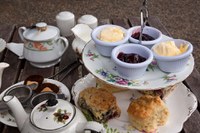Prairie Fare: January is National Hot Tea Month
(Click an image below to view a high-resolution image that can be downloaded)
By Julie Garden-Robinson, Food and Nutrition Specialist
NDSU Extension Service
“I could fall asleep drinking coffee,” my husband has said.
That doesn’t work for me. If I even sniff a caffeinated beverage past 3 p.m., I am wide awake, staring at the ceiling, when I should be asleep.
If I want a warm beverage without any calories late in the day, I choose decaffeinated green tea or herbal tea. In fact, I amassed a treasure trove of assorted tea during the holidays just in time for January, which is National Hot Tea Month.
I have peppermint, chamomile, peach and raspberry herbal tea, along with green and black tea, to sip this winter. All I need is a magazine and a blanket and I am cozily ready to wait for spring.
About 80 billion servings of tea are consumed in the U.S., according to the Tea Association of the U.S.A. Most (85 percent) of the tea consumed is black tea.
Tea has a long history and is the second most widely consumed beverage worldwide. Water is the most popular, by the way. A growing body of research shows some health benefits linked with drinking tea.
Tea leaves are derived from an evergreen shrub (Camellia sinensis) native to Asia. Tea can be classified into several types, including green, yellow, white, oolong and black.
For example, to make black tea, the leaves are wilted, oxidized and dried followed by a heating step. Oxidation means the natural enzymes in the tea plant cause the leaves to become darker. Green tea is “unwilted and unoxidized.”
Researchers have studied the potential health benefits of the naturally occurring plant chemicals (phytochemicals) in tea. Tea is high in antioxidant compounds, which may protect the cells throughout our body from damage.
As a result of these natural compounds, drinking tea may reduce our risk for heart disease and help manage blood pressure and blood cholesterol levels, among other health benefits.
For example, a U.S. Department of Agriculture study showed that drinking five cups of black tea daily, in conjunction with a healthful diet, reduced LDL (bad) blood cholesterol in just three weeks. Another group of researchers showed that drinking black tea helped people manage their blood pressure.
When we manage our heart health through exercise and a healthful diet, we also may help preserve our brain function. Add some green or black tea consumption to the healthy lifestyle mix and you may protect your brain and memory even more.
Drinking tea also may help with weight management or loss. According to one research group, drinking 2 1/2 cups of green tea daily may raise the metabolic rate and help with fat breakdown.
Other researchers have shown the potential of tea consumption in reducing the risk of certain types of cancer, including colon and skin cancer. Yet other researchers have examined the effect of tea and bone health. Some researchers have reported that their research subjects have stronger bones and muscles as a result of drinking green tea.
What about my favorite herbal teas, which are infusions of herbs or fruits? “Tisane” is another name for herbal tea. Most herbal teas do not contain any “real” tea, so be sure to read the ingredient label to learn more.
The next time you serve a guest a warm beverage, ask if he or she would like tisane. The person might look at you a bit quizzically.
According to the Tea Association of the U.S.A., we should follow general rules for brewing a delicious cup of tea. First, use a teapot to prepare tea. Begin by bringing fresh, cold tap water to full boil. If your water supply is very chlorinated, then use filtered water. Be sure to preheat your teapot with some hot water and cover the teapot during the brewing process.
Use 1 teaspoon of tea per cup (or one tea bag per cup). Next, pour boiling water over the tea and set a timer for three to five minutes, depending on the strength of tea you prefer.
Enjoy a cup of tea regularly this winter. In conjunction with an overall healthful diet and exercise, adding some tea may be well worth your while and warm you in the process.
Drinking tea makes me think of scones, a frequent bread served with tea. Here’s a recipe from the North Dakota Wheat Commission and a bonus recipe for orange butter to try with your scones. Visit https://www.ag.ndsu.edu/food for more recipes and tips for healthful eating.
Cranberry Whole-wheat Scones With Orange Butter
2 c. whole-wheat flour
1 Tbsp. baking powder
1/4 c. brown sugar
1/4 tsp. salt
3 Tbsp. butter
1/4 c. dried cranberries
1 egg, beaten
2/3 to 3/4 c. nonfat milk
In a medium bowl, combine flour, baking powder, sugar and salt. With a pastry blender or knives, cut in butter until the mixture is crumbly. Stir in cranberries and egg. Gradually add milk until a thick dough is formed. More or less milk may be needed. Turn mixture out onto a lightly greased baking sheet. Pat into an 8 1/2-inch-diameter circle. Cut into 16 wedges. Brush with milk. Bake in a preheated 450 oven 10 to 12 minutes. Cool slightly, cut wedges apart if needed and transfer to cooling rack. Serve with orange butter or butter and jelly.
Makes 16 scones. One scone without butter has about 93 calories, 3 grams (g) fat, 3 g protein, 15 g carbohydrate, 2 g fiber and 160 milligrams (mg) sodium.
Orange Butter
1/2 c. butter, softened
1 Tbsp. honey
1 tsp. orange zest
Combine and serve with scones.
Makes 16 servings. Each serving has 60 calories, 6 g fat, 0 g protein, 1 g carbohydrate, 0 g fiber and 0 mg sodium.
(Julie Garden-Robinson, Ph.D., R.D., L.R.D., is a North Dakota State University Extension Service food and nutrition specialist and professor in the Department of Health, Nutrition and Exercise Sciences.)
NDSU Agriculture Communication - Jan. 19, 2017
| Source: | Julie Garden-Robinson, 701-231-7187, julie.garden-robinson@ndsu.edu |
|---|---|
| Editor: | Ellen Crawford, 701-231-5391, ellen.crawford@ndsu.edu |



